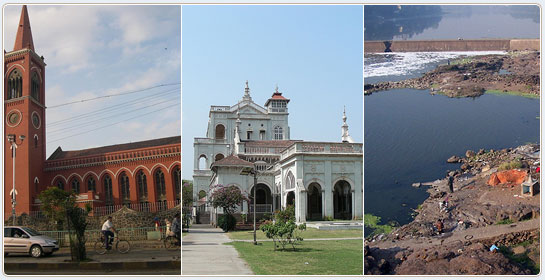Pune Travel Guide:

Introduction
Pune is the eighth largest metropolis in India, the second largest in the state of Maharashtra after Mumbai, and the largest city in the Western Ghats. Once the center of power of the Maratha Empire, it is situated 560 metres above sea level on the Deccan plateau at the confluence of the Mula and Mutha rivers Pune city is the administrative capital of Pune district.
History
Copper plates dated 758 and 768 show that, by the 8th century, an agricultural settlement known as Punnaka existed where Pune is today. The plates indicate that this region was ruled by the Rashtrakuta Dynasty. The Pataleshwar rock-cut temple complex was built during this era.
Pune was part of Yadava Empire of Deogiri from the 9th century to 1327. In 1595, Maloji Raje Bhosale was appointed the jagirdar of Pune and Supe by the Mughals.It was ruled by the Ahmadnagar Sultanate until being annexed by the Mughal Empire in the 17th century.
In 1625, Maharaj Shahaji Raje Bhosale appointed Rango Bapuji Dhadphale as the administrator of Pune. He was one of the first major developers of the town, overseeing construction of the Kasba Peth, Somwar Peth, Raviwar Peth and Shaniwar Peth. After the destruction of the town in raids by the Adil Shahi dynasty in 1630, and again from 1636 to 1647, Dadoji Kondadev, a military and administrative officer of Shahaji Bhosale, oversaw redevelopment and construction of the area. He stabilized the revenue system of Pune and the neighborhoods of Maval to the west of town as well as developed effective methods to control disputes and enforce law and order. Construction began on the Lal Mahal palace, as Shahaji's son Shivaji Bhosale (later Chattrapati Shivaji) was to move there with his mother Jijabai. The Lal Mahal was completed in 1640. Jijabai is said to have commissioned the building of the Kasba Ganapati temple herself. The Ganapati idol consecrated at this temple is regarded as the presiding deity (gramadevata) of the city
Climate
Pune has a tropical wet and dry climate with average temperatures ranging between 20 to 28 °C (68 to 82 °F).
Pune experiences three distinct seasons: summer, monsoon and winter. Typical summer months are from March to May, with maximum temperatures ranging from 30 to 38 °C (86 to 100 °F). The warmest month in Pune is April; although summer doesn't end until May, the city often receives heavy thundershowers in May (and humidity remains high). Even during the hottest months, the nights are usually cool due to Pune's high altitude. The highest temperature ever recorded was 43.3 °C (109.9 °F) on April 30, 1897.
The monsoon lasts from June to October, with moderate rainfall and temperatures ranging from 10 to 28 °C (50 to 82 °F). Most of the 722 mm (28.4 inches) of annual rainfall in the city fall between June and September, and July is the wettest month of the year.
Winter begins in November; November in particular is referred to as the Rosy Cold (literal translation) (Marathi: ?????? ????). The daytime temperature hovers around 28 °C (82 °F) while night temperature is below 10 °C (50 °F) for most of December and January, often dropping to 5 to 6 °C (41 to 43 °F). The lowest temperature ever recorded was 1.7 °C on January 17, 1935
Culture
Pune is said to be the cultural capital of the state of Maharashtra. It epitomizes the Marathi culture, which lays emphasis on education, arts and crafts, music, and theatre. Pune has emerged as a centre of modern architecture in India, with prize winning buildings. Pune culture reflects a blend of traditions with modernity, as along with hosting classical shows, the city also boasts an active nightlife.
Transport
Air :
Pune International Airport is an international airport at Lohegaon, operated by the Airports Authority of India. It shares its runways with the neighboring Indian Air Force base. In addition to domestic flights to all major Indian cities, this airport serves international direct flights to Dubai (operated by Air India Express) and to Frankfurt (operated by Lufthansa).
The Maharashtra Industrial Development Corporation is responsible for the design and construction of a new Pune International Airport. The area between Chakan and Rajgurunagar, around the villages of Chandus and Shiroli, is currently being considered as a construction site. If constructed here, it will be at a distance of 40 km (25 mi) from central Pune
Rail:
Local trains (EMUs) connect Pune to the industrial town of Pimpri-Chinchwad and the hill station of Lonavala, while daily express trains connect Pune to Mumbai, Howrah, Delhi, Jammutawi, Chennai, Hyderabad, Bangalore, Goa, Varanasi, and Jamshedpur. At Pune, there is diesel locomotive shed and electric trip shed. A rapid transit system has been proposed in Pune and is scheduled to begin operations in 2013. Pune Metro Rail is being planned in consultation with Delhi Metro Rail Corporation Limited, the corporation which built and operates the Delhi Metro. It will be a combination of elevated and underground sections, with initial routes being planned between Pimpri-Swargate and Vanaz-Ramwadi.
The city has railway station, Pune Railway Station. The station is administrated by the Pune Railway Division of the Central Railways. All the railway lines to Pune are broad gauge.
Road :
Both public and private transport are popular in Pune. Public buses within the city and its suburbs are operated by the Pune Mahanagar Parivahan Mahamandal Limited (PMPML). The PMPML operates the Pune Bus Rapid Transit system, the first of its kind in India, in which dedicated bus lanes allow buses to travel quickly through the city. Maharashtra State Road Transport Corporation runs buses from its main stations in Shivajinagar, Pune station and Swargate to all major cities and towns in Maharashtra and neighbouring states. Private companies too run buses to major cities throughout India.